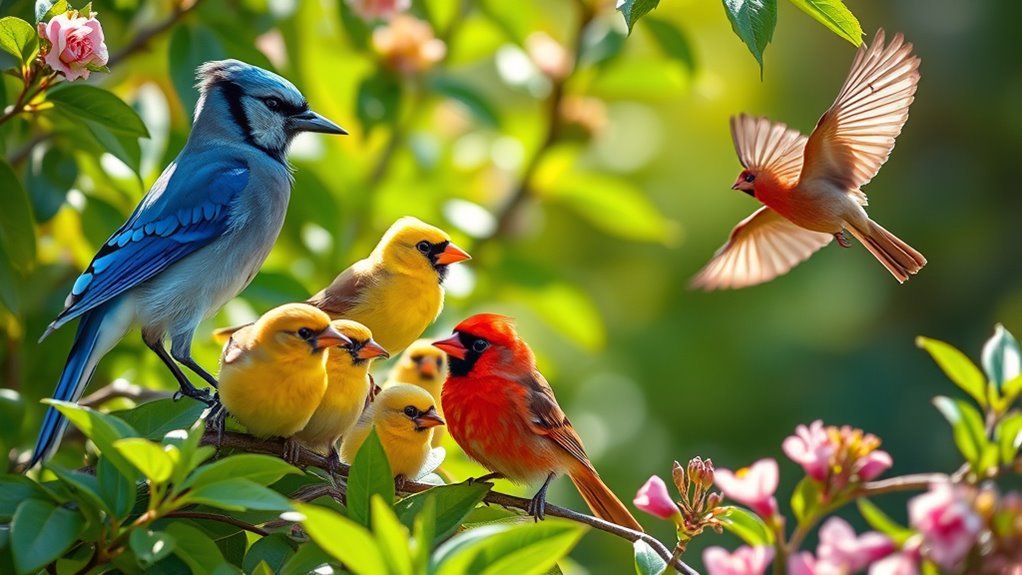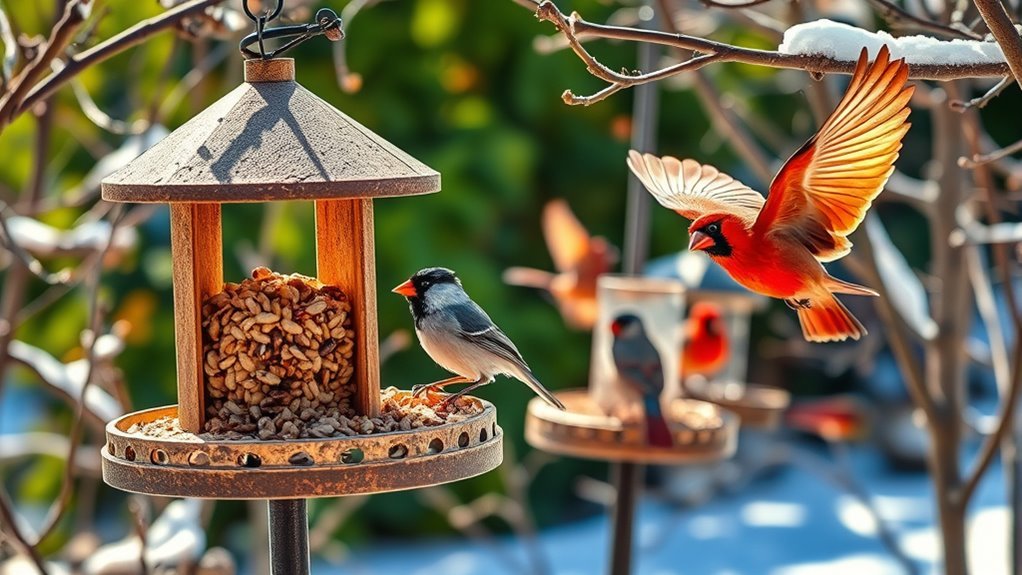Minnesota Backyard Birds
Minnesota's backyard birds showcase the region's rich ecology. These species enhance local biodiversity and indicate the environment's health. By understanding their behaviors and habitats, you can connect more deeply with nature. Learning how to attract these birds helps you understand their needs and preferences. This knowledge makes observing them more enjoyable, allowing you to appreciate the full experience of birdwatching.
Key Takeaways
- Common backyard birds in Minnesota include American robins, black-capped chickadees, and blue jays, each with unique behaviors.
- Attract birds with feeders using sunflower seeds, safflower, and nyjer seeds, tailored to different species' preferences.
- Create bird-friendly habitats by planting native plants like coneflowers and installing nesting boxes in safe locations.
- Practice bird watching etiquette by maintaining a safe distance, keeping noise levels low, and avoiding disturbances.
- Understanding local bird behaviors enhances appreciation for wildlife and supports conservation efforts in Minnesota.
Overview of Minnesota's Avian Diversity

Minnesota is known for its beautiful landscapes, but it's also home to a wide variety of birds. The state has different habitats that provide homes for many bird species, making it an important place for studying bird migration.
From the northern forests to the southern wetlands, you can see many different types of birds that highlight both local culture and global ecosystems. This variety shows why bird conservation is important, as many species are threatened by climate change and habitat loss.
Joining conservation efforts helps to protect these vital migration routes. Learning about birds not only enhances your appreciation of Minnesota's natural beauty but also helps you feel more connected to this ecological community.
Common Backyard Birds in Minnesota
Minnesota has a variety of common backyard birds that you can easily observe. Some of these birds include the American robin, black-capped chickadee, and blue jay. These species offer interesting insights into local bird behavior and migration.
American robins typically return in spring after migrating south for the winter. Their arrival marks a seasonal change in the area.
Black-capped chickadees show social behavior, often forming mixed flocks during winter months.
Watching these birds in your backyard can help you feel more connected to Minnesota's ecosystem. You can learn about their habits and how they adapt to their environment.
Understanding these common species can deepen your appreciation for the wildlife around you.
Attracting Birds With Feeders

To attract a wide range of birds to your backyard, use bird feeders effectively.
Start by selecting different types of feeders. Tube feeders work well for small birds, while platform feeders are better for larger species. Each feeder type serves a specific purpose and attracts various birds.
Next, choose the right seeds. A mix of sunflower seeds, safflower, and general seeds will draw many birds. Use nyjer seeds to attract finches and suet to invite woodpeckers.
Place your feeders where you can see them easily and near plants or shrubs to offer safety for the birds.
Creating a Bird-Friendly Habitat
Transforming your backyard into a bird-friendly space is easy and rewarding. Start by planting native Minnesota plants. These include coneflowers, sunflowers, and berry bushes. Native plants provide food and shelter for different bird species.
Add layers to your garden with trees, shrubs, and ground cover. This variety helps accommodate various birds.
Next, install nesting boxes. Place these at the right height and facing away from strong winds. Clean and maintain them regularly to encourage birds to return.
Seasonal Bird Watching in Minnesota

While exploring Minnesota's seasons, you'll see many birds migrating throughout the year. Knowing their migration patterns can improve your bird watching experience.
In spring, robins and warblers return from warmer areas, displaying bright colors and lively behavior.
During summer, birds nest in local areas, turning your backyard into a busy spot.
In autumn, geese and ducks fly south, marking the arrival of winter.
In winter, you can spot resilient birds like chickadees and cardinals that adjust to the cold.
Benefits of Bird Watching
Bird watching offers many benefits that go beyond observation.
First, it supports mental health by promoting mindfulness and lowering stress levels. Watching different birds helps you stay present and feel calm.
Second, bird watching is a great way for families to bond. Working together to set up feeders or going on nature walks creates shared experiences that strengthen family ties. You'll appreciate nature more as a family while making lasting memories.
Lastly, joining local birding groups can help you make new friends and build community connections.
Identifying Minnesota's Birds
To identify Minnesota's birds, focus on three main traits: size, color patterns, and behaviors. Observe the bird's shape and listen to its sounds for better identification.
Use a field guide or a bird identification app for assistance. Keep binoculars close to see distant birds clearly.
Watch for seasonal changes, as some birds migrate, which allows you to learn more.
Join local birdwatching groups to meet other bird lovers and share knowledge. Engaging with the birdwatching community will improve your skills in recognizing Minnesota's birds.
Enjoy the experience of watching and learning about these fascinating creatures.
Bird Watching Etiquette
When you watch birds in Minnesota, follow simple rules to keep birds safe and enjoy the experience.
Stay at a safe distance from nests and feeding areas to avoid disturbing their natural activities. Don't play loud bird calls or recordings, as this can stress the birds.
Keep noise low and respect the space of fellow birdwatchers. If you're with a group, ensure everyone knows these rules.
Local Birding Events and Hotspots
Minnesota offers great birding opportunities throughout the year. Participating in local birding festivals, like the Minnesota Birding Weekend, is a wonderful way to connect with other bird watchers and learn from experts.
These festivals often include guided tours, workshops, and presentations about local birds.
Popular birding spots, such as the Minnesota Valley National Wildlife Refuge and Whitewater State Park, are excellent for spotting both migratory and resident bird species.
Joining local birdwatching groups can also enhance your experience. These groups organize outings that foster community and shared interest.
Engaging in these events and visiting well-known locations will help you improve your birding skills and enjoy time with fellow birdwatchers.
Gardening for Birds in Minnesota
Creating a bird-friendly garden in Minnesota can improve your birdwatching experience.
To attract different bird species, add plants that offer food, shelter, and nesting sites. Use native plants, as they fit well in the local environment and support wildlife.
Select seeds from plants like coneflowers, asters, and sunflowers. These plants attract songbirds and ground feeders.
Including shrubs like elderberry and serviceberry is also important since birds enjoy eating their berries.
By incorporating these elements into your garden, you'll support a healthy ecosystem.
You'll promote biodiversity and create a welcoming habitat for birds. Enjoy improving the natural space in your backyard.
Resources for Bird Enthusiasts
If you love birdwatching in Minnesota, many resources can improve your experience. Local groups, such as the Audubon Society, offer workshops and events focused on birdwatching skills and technology. These help you observe birds better.
Apps like Merlin Bird ID and BirdLog assist you in identifying species and tracking sightings, making your birdwatching more interactive and fun.
Joining local birding clubs helps you meet fellow birdwatchers and supports wildlife conservation projects. You can also find many online forums and social media groups where you can discuss birdwatching, share tips, and exchange experiences.
Frequently Asked Questions
What Are the Best Times of Year for Birdwatching in Minnesota?
The best times for birdwatching in Minnesota are during spring and fall migrations. In spring, you can see many species returning after winter. In fall, birds prepare to leave for warmer places. These migration periods offer great chances to observe different birds in your area. Enjoy the variety and beauty of these unique seasons!
How Do I Know if a Bird Is Nesting in My Yard?
To find out if a bird is nesting in your yard, look for signs like nest materials and the structure of the nest. Pay attention to bird behavior, such as their frequent visits, carrying food, or acting protectively. These observations will help you understand their activities and determine if they are nesting.
Are There Any Invasive Bird Species in Minnesota?
Yes, Minnesota has invasive bird species. The European starling and house sparrow are two examples. These birds can negatively impact local ecosystems. It is important to assess their effects to understand how they influence the environment. This awareness fosters responsibility for local wildlife.
What Do I Do if I Find an Injured Bird?
If you find an injured bird, check its condition first. Look for visible injuries or signs of distress. Then, find local bird rehabilitation options or contact a bird rescue organization. They can help care for the bird and improve its chances of recovery.
Can I Attract Specific Bird Species to My Yard?
You can attract specific bird species to your yard. Use bird feeders filled with their favorite seeds. Plant native plants that offer food and shelter. This creates a welcoming space for them.

Hello, I’m Amelia White, the founder of birdsfanatic.com. As a lifelong bird enthusiast and spiritual seeker, I’ve always been fascinated by the mystical connections between birds and the human experience. On this site, I share my knowledge and insights into the symbolic meanings and spiritual significance of various bird species, exploring their roles in mythology, folklore, and cultural traditions. Join me on this journey into the world of birds, where we’ll discover the hidden wisdom and guidance that these magnificent creatures have to offer.







